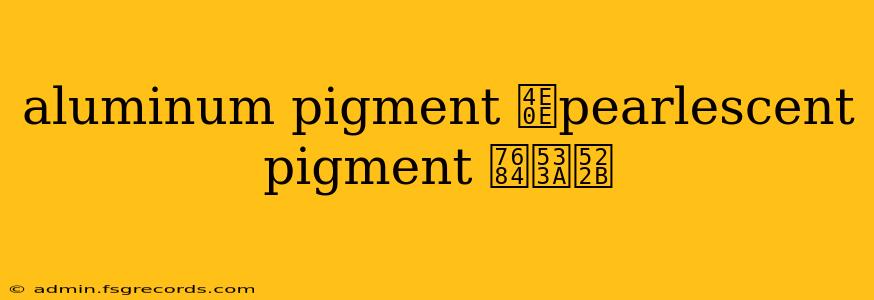Aluminum Pigment vs. Pearlescent Pigment: Key Differences and Applications
Aluminum pigments and pearlescent pigments are both used to create visually appealing effects in coatings, inks, and plastics, but they achieve these effects through vastly different mechanisms. Understanding their key differences is crucial for selecting the right pigment for a specific application.
What is Aluminum Pigment?
Aluminum pigment is a metallic pigment composed of microscopic flakes of aluminum. These flakes are highly reflective, giving coatings a metallic sheen and excellent opacity. The brightness and color of the metallic effect depend on the size and shape of the aluminum flakes, as well as the surface treatment applied. Aluminum pigments are known for their:
- High reflectivity: They provide excellent coverage and a strong metallic appearance.
- Good heat and light stability: They are relatively resistant to degradation from UV exposure and high temperatures.
- Cost-effectiveness: Aluminum pigments are generally less expensive than pearlescent pigments.
- Excellent barrier properties: They can offer protection against corrosion and environmental factors.
What is Pearlescent Pigment?
Pearlescent pigments, also known as interference pigments, are composed of coated mica flakes or other crystalline substrates. These substrates are coated with multiple layers of metallic oxides, such as titanium dioxide and iron oxide, creating interference effects. Light interacting with these layered coatings causes the characteristic pearlescent or iridescent sheen, which changes with the viewing angle. Key features of pearlescent pigments include:
- Iridescent effect: They create a shimmering, color-shifting effect that changes depending on the angle of observation.
- Variety of colors and effects: The combination of substrate and coating materials allows for a wide range of colors and iridescence levels.
- High brilliance and depth: Pearlescent pigments can impart a luxurious and sophisticated appearance.
- Higher cost: Generally more expensive than aluminum pigments due to the complex manufacturing process.
Key Differences Summarized:
| Feature | Aluminum Pigment | Pearlescent Pigment |
|---|---|---|
| Base Material | Aluminum flakes | Coated mica flakes or other substrates |
| Effect | Metallic sheen, opacity | Iridescent, color-shifting sheen |
| Reflectivity | High | High, but with color interference |
| Cost | Relatively low | Relatively high |
| Color | Primarily silver, can be modified | Wide range of colors and effects |
| Application | Automotive coatings, packaging, etc. | Cosmetics, automotive coatings, etc. |
Applications: Where to Use Each Pigment
The choice between aluminum and pearlescent pigments depends heavily on the desired aesthetic effect and performance requirements.
Aluminum Pigments are ideal for:
- Automotive coatings: Providing a durable and reflective finish.
- Packaging: Creating a metallic look on food containers, cans, and other products.
- Industrial coatings: Protecting surfaces from corrosion and wear.
- Paints and inks: Adding a metallic sheen.
Pearlescent Pigments are excellent for:
- Cosmetics: Adding shimmer and luminosity to makeup and skincare products.
- Automotive coatings: Creating unique and eye-catching finishes.
- Plastics: Enhancing the appearance of plastic parts.
- High-end paints and inks: Achieving a luxurious and sophisticated look.
Conclusion
Both aluminum and pearlescent pigments offer unique visual effects and performance characteristics. The best choice depends on the specific application's needs, budget, and desired aesthetic. While aluminum pigments provide a strong metallic effect at a lower cost, pearlescent pigments offer a wider range of colors and the distinctive iridescent shimmer that can elevate a product's visual appeal. Understanding these fundamental differences is critical for selecting the optimal pigment and achieving the desired results.

